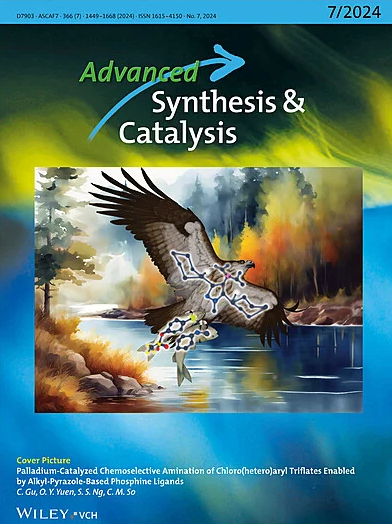Photoredox/Nickel Dual Catalytic C(sp2)S Cross‐coupling of Bromoanilines Enabled by Mineral Acids
IF 4
2区 化学
Q2 CHEMISTRY, APPLIED
引用次数: 0
Abstract
Cross‐coupling reactions are essential tools in modern organic synthesis, enabling the formation of carbonheteroatom (CX) bonds. Despite significant advancements in method development, particularly with palladium, copper, and nickel catalysis, including recent progress in photoredox catalysis, their efficiency is often limited when sensitive functional groups, such as thiols and amines, are present in the nucleophile or electrophile, and typically requires extensive protection–deprotection strategies. Herein, a practical synthetic approach is reported that employs mineral acids as unconventional reagents to facilitate C(sp无机酸催化溴苯胺的光氧化还原/镍双催化C(sp2) - 5s交叉偶联
交叉偶联反应是现代有机合成中必不可少的工具,可以形成碳杂原子(C - X)键。尽管在方法开发方面取得了重大进展,特别是钯、铜和镍催化,包括光氧化还原催化的最新进展,但当敏感官能团(如硫醇和胺)存在于亲核试剂或亲电试剂中时,它们的效率往往受到限制,并且通常需要广泛的保护-去保护策略。本文报道了一种实用的合成方法,该方法采用无机酸作为非常规试剂,促进溴苯胺(或其他具有游离伯胺作为官能团的亲电试剂)和硫醇之间的C(sp2) S交叉偶联,从而消除了保护基团操作的需要。此外,质子化改变了苯胺部分的电子影响,将其从供电子基转变为吸电子基,从而促进氧化加成,酸性介质抑制多硫酯的形成,增强了镍催化剂的可及性,减少了光催化中的内部过滤效应。该策略能够在广泛的底物范围内高效高产地合成氨基硫醚,强调酸辅助交叉偶联作为C(sp2) - S键形成的流线型和稳健的光氧化还原方法的价值。
本文章由计算机程序翻译,如有差异,请以英文原文为准。
求助全文
约1分钟内获得全文
求助全文
来源期刊

Advanced Synthesis & Catalysis
化学-应用化学
CiteScore
9.40
自引率
7.40%
发文量
447
审稿时长
1.8 months
期刊介绍:
Advanced Synthesis & Catalysis (ASC) is the leading primary journal in organic, organometallic, and applied chemistry.
The high impact of ASC can be attributed to the unique focus of the journal, which publishes exciting new results from academic and industrial labs on efficient, practical, and environmentally friendly organic synthesis. While homogeneous, heterogeneous, organic, and enzyme catalysis are key technologies to achieve green synthesis, significant contributions to the same goal by synthesis design, reaction techniques, flow chemistry, and continuous processing, multiphase catalysis, green solvents, catalyst immobilization, and recycling, separation science, and process development are also featured in ASC. The Aims and Scope can be found in the Notice to Authors or on the first page of the table of contents in every issue.
 求助内容:
求助内容: 应助结果提醒方式:
应助结果提醒方式:


